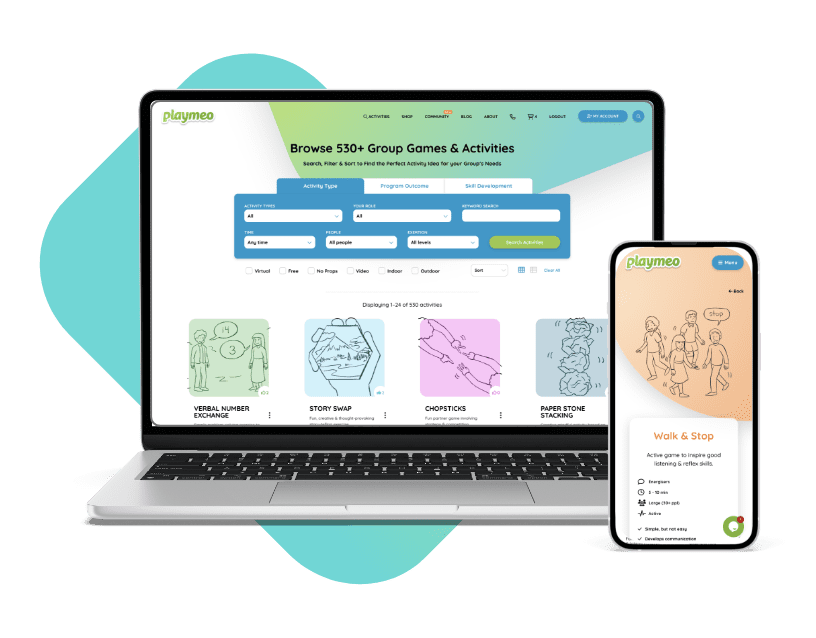Download our free 28-page ebook jam-packed with outrageously fun activity ideas.
This post is the first of four articles designed to help you effectively lead large group programs.
- What’s So Special About Large Groups? (this article)
- Essential Tips for Working with Large Groups – Part 1
- Essential Tips for Working with Large Groups – Part 2
- How To Get Your Group’s Attention
What’s So Special About Large Groups?
I love standing before groups and leading them through a series of fun, interactive group games.
More specifically, I love leading LARGE group programs.
And by “large” I mean at least 50 people, but more often, 100, 200 or up to 3,000 people.
Indeed, my enthusiasm for big groups led me to write Count Me In, a book featuring 140+ large group activities that work.
Now, I know that many leaders (maybe, you?) are not as fond of leading large group programs as I am. So, here’s my take on why working with large groups is so distinctively special and a few clues to help you survive.
1. Energy
The larger the group, the more energy they generate. This means you don’t have to do or say so much to move or motivate the group.
You’ve heard the saying; there’s a clown in every group. Well, the larger the group, the more likely you’ll have the entire circus turn up.
Strangely, large groups tend to find me funnier than smaller groups. The thing is, though – I contribute a lot less with large groups, often because I can’t get a word in edge-ways! So, I guess it must be the group’s energy that tickles their collective funny bone.
Also, large groups of people invariably do not arrive together, nor all on time. So, another key advantage of big groups is that on most occasions, enough people have arrived to form a quorum to get started on time (see Unofficial Starts for ideas to keep the early birds busy.) Get ‘em busy, I say. I hate waiting around too.
However, let’s be honest – the numbers are not in your favour if things don’t go as planned. Large numbers tend only to exacerbate the anxious feelings you initially worked so hard to hide. Also, if you don’t have a good strong voice or don’t have access to a good PA system, you’ll lose your voice before recess. Not to mention losing your group because they can’t hear you. Hint: click here and here to learn how to preserve your voice.
2. Resources
Large groups consume a lot of stuff – space, time, leaders and equipment.
Large groups are fantastic when you plan to lead a series of ‘no prop’ style activities within an acoustically-perfect indoor stadium. But, for every other occasion, you’re up for lots of ‘more.’
- More props to equip everyone with whatever ever they need to play with (think issues of not having enough to go around, or worse, not getting it all back at the end).
- More leaders to spread the load of delivery (think opportunities for fun teamwork, but more effort to involve and communicate effectively).
- More time because it just takes longer for a larger group to stop playing, or quieten down, or assemble, or move to another spot, etc.
- More space because, well, …you get the idea.
My advice – factor all of these ‘mores’ into your large group program.
3. Safety
It’s easy to hide in a large group because it’s true, unlike a small group, you don’t stand out as much, and there are too many people to pay particular attention to. Consider the positive impact this fact may have on your program, especially within the context of a fun, interactive and non-threatening program of activities – participants can more comfortably make appropriate choices regarding their level of participation.
For example, in large groups, people who tend to be less outgoing enjoy the fact that there is no particular focus on them as they undertake an activity because everyone else is busy too. Standing at the back of the group is also a safe place to be to avoid the potential of being seen or chosen as a ‘volunteer.’ Simply put, there’s safety in numbers.
Of course, the downside is that owing to the sheer size of the group, you may not notice that a particular person is missing or is uncomfortable. It is also true that it’s harder for you to maintain a watchful eye on everything – there’s just too much going on with large groups – physically, mentally and emotionally.
Keep in mind that being big opens up all sorts of opportunities for distracting behaviour too, including my pet-hate – side-conversations – all under the guise of the ‘no-one-will-notice-me’ banner.
Next Up
Next, we explore how you can optimise the good (and limit the not-so-good) characteristics of delivering large group programs by sharing many of my most successful tips and tricks.
Essential Large Group Tips: Part 1
Essential Large Group Tips: Part 2













Original post June 2023, last updated March 2024.